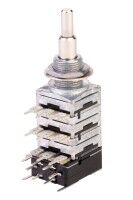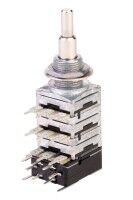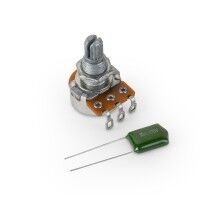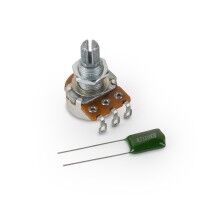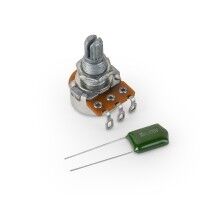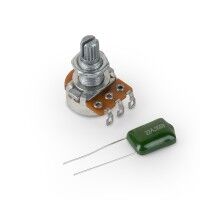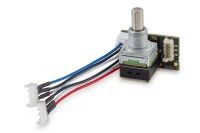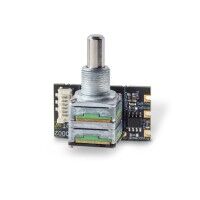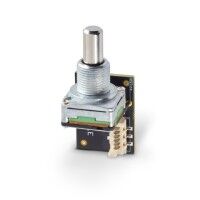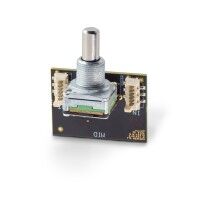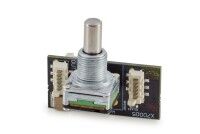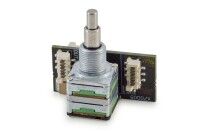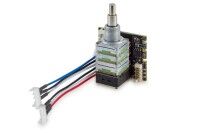









Get a 4 year extended warranty
Wouldn’t it be great, if we doubled the warranty for your product to 4 years? Sounds really good, doesn’t it? All you need to do for this warranty extension is to register your product with us. So, what are you waiting for?
More informationThe potentiometer - used millions of times, yet little noticed
In a variety of electrical circuits, the potentiometer, or pot for short, represents one of the interfaces between humans and electronics. Before the era of voice assistants like Siri, Google Assistant, Alexa..., the music was turned up loud and quiet by hand. Or you turned up the bass, dimmed lights, changed sounds in the studio, and so on. All this is done with the help of the little star of electrical engineering, the adjustable resistor, or in technical jargon: the potentiometer. Hardly any device can do without one.
More than 100 years before Marshall - a Brit lays the foundation for Rock ́n ́Roll
In 1840, the British physicist Charles Wheatstone (yes, the British have always been a leading force in rock ́n ́roll) invented the evergreen of electrical engineering. The idea is simple and ingenious: a sliding contact (wiper) travels over a fixed resistive element. The adjustable resistor (voltage divider) was born! Essentially, two types of potentiometers have developed from this, and both have a home in the music business: rotating, known as "potentiometer" or “thumb pot”, and slidable, also known as "fader". In contrast to these mechanical potentiometers, digital potentiometers are widely used today. In their almost wear-free construction, they have very little in common with the classic rotating potentiometer. Their application today is extremely wide-ranging, from consumer electronics to synthesizers and professional studio equipment. However, digital potentiometers do not work in analogue circuits.
The adjustable resistor - small and versatile
Rotating potentiometers usually have an axis that can be rotated by 300°. However, there are also multiturn potentiometers, which allow for a much wider control path. They are mainly used where fine-tuning is particularly important.
Potentiometers are indispensable in electrical instruments and their amplifiers. The prime example of this is the volume control. It is designed logarithmically (as opposed to "linear"), which means that when adjusting the wiper (sliding contact) on the resistive element, less happens at the beginning of the rotation than towards the end. This corresponds much better to human perception, and thus allows more sensitive adjustments. The value of the resistance between the two outer terminals of the pot is given in kilo (1000) ohms, or kΩ for short. Especially with the very popular passive tone control in electric guitars, different values have an influence on the control range, and thus on the sound. In active circuits, often used in effect pedals or in the tone control of electric basses, sometimes a so-called trimmer potentiometer can be found. With it, a certain value, such as the output power, or volume is adjustable. Tandem potentiometers, or concentric pots, are also often found on instruments. With almost the same size, they offer two axes (and wipers and resistive elements) and are therefore two potentiometers in one.
The anatomy of the component
The fixed resistive element is located in the housing of the potentiometer. It is equipped with contacts at both ends, which represent two of the three terminals outside the housing. The wiper is mounted on the adjustable axis. By turning (or sliding) it, contact with the resistive element at various points is made. Thus, the electrical resistance of the potentiometer is changed. The wiper is connected to the third, central terminal of the potentiometer. Soldered by cables, these are connected to the circuit, which now has a variable resistance by turning the axis. The value of the electrical resistance is measured between the two end terminals. However, other parameters, such as the maximum current that the glider can transmit, or the maximum dielectric strength can also be important for amplifier circuits.
Spare part or sound tuning?
Like all mechanical components, the potentiometer (Parts for Electric Guitars | Parts for Instruments | W-Music Distribution (warwick.de) with its rotating axis, the wiper, and the fixed resistive element, on which the wiper always travels, gets gradually worn out. An old, intensively used pot, is noticeable by making scratching or crackling noises while being used. Although a short-term remedy can be provided by using cleaning supplies for electronic components, or even dismantling, cleaning and reassembling the entire component, the potentiometer is usually replaced in such a case – done by yourself, if you have a soldering iron and a little experience with it, or at a specialist workshop.
For guitarists and bassists, however, this component also offers potential for "improvement" or adaptation to personal taste. Especially tone or volume controls are often replaced (250kOhm <> 500kOhm), and thus their response and possibly the tone of the instrument gets changed. When in doubt, the only thing that helps, is to try it out! Whether logarithmic or linear potentiometer, whether for soldering or equipped with plug connections, average or better quality (e.g., linearity), there are a few things to consider if you want to approach the inner values of your instrument. Based on the size of its housing, one can often draw conclusions about the mechanical quality of a potentiometer. Since the adjustable resistor itself is often used as a stylistic device for the electric guitar (e.g., volume swells by hand), this is particularly important. Because a noisy potentiometer, excessively amplified by a loud amp in the drive channel, is usually no reason to rejoice! And who wants to regularly take out the soldering iron for repairing the electronics of his guitar?

